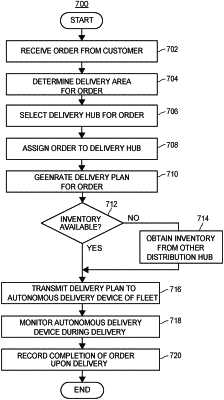| CPC G06Q 10/08345 (2013.01) [G06N 20/00 (2019.01); G06Q 10/0838 (2013.01); G06Q 30/0283 (2013.01)] | 20 Claims |

|
1. A computer-implemented method for adjusting order delivery fees, the method comprising:
receiving, at one or more processors, a set of order data associated with a particular order by a customer, the order data indicating order details associated with the particular order and customer details associated with the customer;
receiving, at the one or more processors, a set of delivery data associated with the particular order, wherein the delivery data includes data on fleet availability of a fleet of delivery devices and expected demand for delivery services at a time of the particular order;
determining, by the one or more processors, a delivery hub from a plurality of delivery hubs to fulfil the particular order based upon the order details and the customer details, wherein the delivery hub is associated with a plurality of delivery devices of the fleet of delivery devices;
training, by the one or more processors, a plurality of machine learning (ML) models for each of the plurality of the delivery hubs by performing one or more statistical analyses on one or more sets of historical order data and one or more sets of historical delivery data associated with the respective delivery hub, each of the plurality of ML models trained to determine combinations of optimal order delivery fees and optimal delivery times for the delivery hub, wherein each of the plurality of ML models is further associated with one or more sets of the following attributes: order time, weather conditions, delivery location, number of available delivery devices, and distance between the delivery location and the corresponding delivery hub;
accessing, by the one or more processors, an ML model selected from the plurality of ML models for the delivery hub;
determining, via the ML model, one or more optimal combinations of variable order delivery fees and delivery times for the particular order by the customer to provide order fulfilment based on the set of order data and the set of delivery data associated with the particular order, wherein the variable order delivery fees are determined based upon the order details of the particular order, the availability of the fleet delivery devices at the time of the particular order, and the expected demand for delivery services at the time of the particular order;
communicating, via a user interface, to the customer, one or more options associated with the optimal combinations of variable order delivery fees and delivery times;
receiving, at the one or more processors, a customer selection associated with the one or more options, the customer selection indicating one or more of the delivery times associated with the one or more optimal combinations;
generating, at the one or more processors, a distribution plan for controlling the one or more of the delivery devices, wherein at least one of the delivery devices is an autonomous delivery device, to fulfill the particular order based at least in part upon the set of delivery data and the one or more delivery times based on the customer selection, the distribution plan including a delivery plan for the one or more delivery device to deliver the particular order to a delivery location associated with the customer;
dispatching, by the one or more processors, one or more of the delivery devices to fulfil the particular order according to the distribution plan by the one or more delivery times based on the customer selection;
determining, by the one or more processors, one or more observed delivery times at which the particular order was fulfilled by the one or more delivery devices; and
updating, by the one or more processors, the ML model based upon the one or more observed delivery times.
|